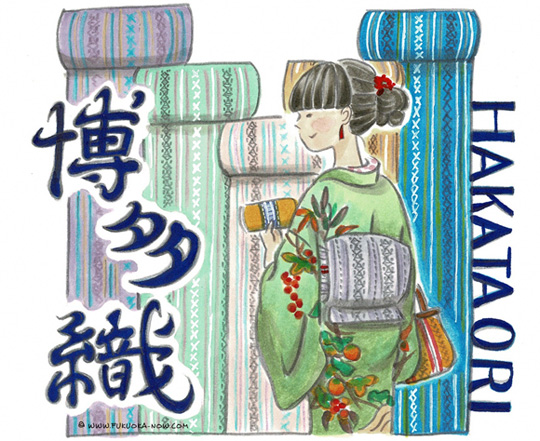Hakata Culture vol.140
Hakata-ori Textiles Turn 777

According to one theory, Hakata is the birthplace of the woven textiles in Japan. The industry is said to have begun after a merchant named Yazaemon Mitsuda brought back weaving techniques from Song Dynasty China in the 13th century. These techniques were passed down through the Mitsuda family and became known as kanton-ori. After a series of tweaks and improvements, this style of weaving, which was distinct to Hakata, came to be known as Hakata-ori.
Two hundred and fifty years later, Yazaemon’s descendant Hikosaburo Mitsuda sailed to Ming Dynasty China to study weaving techniques. He brought back what he learned and incorporated it into the family’s style of weaving, thus resulting in a shiny, thicker fabric similar to taffeta. Over time, unique patterns like the single-prong tokko and the hanasara flower tray emerged. The fabric itself was extremely stiff, making it just right for obi (kimono belts).
The year 2018 marks the 777th anniversary of Hakata-ori. Its reputation as a high-quality textile dates back centuries. In the Edo era, the lords of the Fukuoka domain used to send Hakata-ori to Edo (now, Tokyo) as tribute to the shogunal government. Not many people wear kimono these days, so a range of other items—from bags to neckties to interior decorations—are now made from Hakata-ori. Several commemorative events have already been held this year, and a special logo featuring a distinctive Hakata-ori design has been created.
What’s more, the Traditional Craft Products Month National Convention, which is held in a different part of Japan every year in November, will be held in Fukuoka this year at Marine Messe. Be sure to stop by and see all the traditional crafts from Fukuoka and the rest of Japan. Also, in November, a Hakata-ori Trade Show will be held at Jotenji Temple, which is said to be the birthplace of Hakata-ori textiles. A large number of items will be on sale, so don't miss it!
今年で誕生から777年を迎えた博多織
一説によると、博多は日本の織物の発祥地と言われています。13世紀に、博多商人の満田弥三右衛門が中国・宗から持ち帰った唐織の技術が、日本における本格的な織物の始まりと伝わるからです。この織物技術は満田家の家伝となり、当初は「広東織」と称していました。その後、さまざまな工夫や改良が加えられて、やがて博多を代表する特産品「博多織」となっていきます。
弥三右衛門から250年後、子孫の満田彦三郎が再び中国・明へ渡り、織物の技術を研究します。織物技術を学んだ彦三郎は帰国後に家伝の織物に改良を重ねて、琥珀織(タフタ)に似た光沢のある厚手の織物を完成させます。独鈷や華皿など独特の模様が浮き出た織物は、生地が非常に堅く、帯に向いた反物でした。この織物は「覇家台織(はかたおり)」と名づけられます。
2018年、博多織は誕生から777年を迎えました。江戸時代には福岡藩から幕府への献上品になるなど、品質の高さには昔から定評があります。近年は着物を着る人が少なくなりましたが、バッグやネクタイ、インテリア素材など、博多織の新しい活用法も生まれてきました。今年はさまざまな記念事業が行われ、博多織の代表的な模様をデザインしたロゴマークもつくられています。
さらに今年は伝統的工芸品の魅力を発信するために、毎年全国各地で開かれている「伝統的工芸月間国民会議全国大会」が11月に福岡で開催されます。博多織をはじめとした福岡の伝統工芸品はもちろん、全国からたくさんの伝統工芸品がマリンメッセ福岡に集まります。また同じく11月には博多織発祥の碑がある承天寺で、多くの博多織が出品される博多織求評会も行われます。

